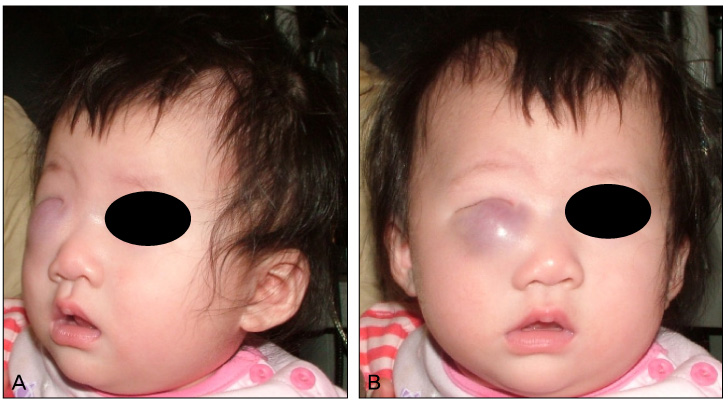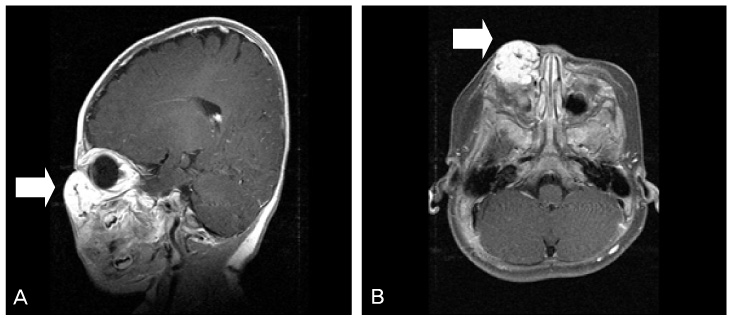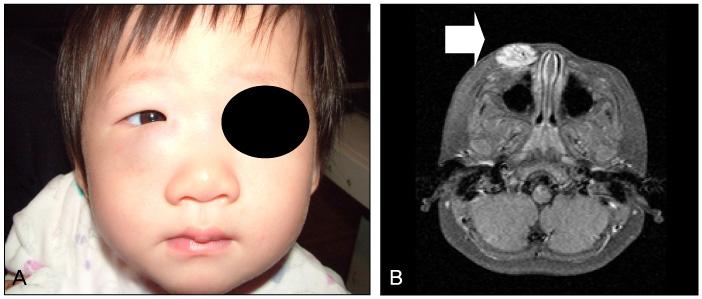J Korean Ophthalmol Soc.
2012 Apr;53(4):607-611.
A Case of Periocular Capillary Hemangiomas Treated With Propranolol as a Single Therapy
- Affiliations
-
- 1Department of Ophthalmology, School of Medicine, Chosun University, Gwangju, Korea. eyelovehyun@hanmail.net
Abstract
- PURPOSE
To report a case of periorbital infantile capillary hemangioma treated with propranolol as a single therapy.
CASE SUMMARY
A 3-month-old girl with a growing red-purple mass on the right lower eyelid visited our clinic. The patient was diagnosed with capillary hemagioma by imaging studies. The mass had grown rapidly, and the visual axis was obscured in the follow-up. Oral propranolol therapy was initiated at a starting dose of 0.17 mg/kg at 8-hour intervals. After 2 doses, the propranolol was doubled, and after another 2 doses, the daily dose of 0.67 mg/kg divided into 3 was maintained. Three days after the initiation of the treatment, the color of the hemangioma had changed from red-purple to light purple, and the hemangioma had softened. The hemangioma continued to respond well with no side effects in the following 10 months.
CONCLUSIONS
The authors suggest that oral propranolol treatment as a possibility of an effective and safe option for the vision-threatening periorbital capillary hemangioma as a single therapy.
Keyword
MeSH Terms
Figure
Reference
-
1. Shields JA. Diagnosis and Management of Orbital Tumors. 1989. Philadelphia: WB Saunders;124.2. Haik BG, Jakobiec FA, Ellsworth RM, Jones IS. Capillary hemangioma of the lids and orbit: an analysis of the clinical features and therapeutic results in 101 cases. Ophthalmology. 1979. 86:760–792.3. Haik BG, Karcioglu ZA, Gordon RA, Pechous BP. Capillary hemangioma (infantile periocular hemangioma). Surv Ophthalmol. 1994. 38:399–426.4. Stigmar G, Crawford JS, Ward CM, Thomson HG. Ophthalmic sequelae of infantile hemangiomas of the eyelids and orbit. Am J Ophthalmol. 1978. 85:806–813.5. George ME, Sharma V, Jacobson J, et al. Adverse effects of systemic glucocorticosteroid therapy in infants with hemangiomas. Arch Dermatol. 2004. 140:963–969.6. Zarem HA, Edgerton MT. Induced resolution of cavernous hemangiomas following prednisolone therapy. Plast Reconstr Surg. 1967. 39:76–83.7. Kushner BJ. Local steroid therapy in adnexal hemangioma. Ann Ophthalmol. 1979. 11:1005–1009.8. Léauté-Labrèze C, Dumas de la Roque E, Hubiche T, et al. Propranolol for severe hemangiomas of infancy. N Engl J Med. 2008. 358:2649–2651.9. Gillette P, Garson A Jr, Eterovic E, et al. Oral propranolol treatment in infants and children. J Pediatr. 1978. 92:141–144.10. Haider KM, Plager DA, Neely DE, et al. Outpatient treatment of periocular infantile hemangiomas with oral propranolol. J AAPOS. 2010. 14:251–256.11. Holmes WJ, Mishra A, Gorst C, Liew SH. Propranolol as first-line treatment for rapidly proliferating infantile haemangiomas. J Plast Reconstr Aesthet Surg. 2011. 64:445–451.12. Lee EK, Choung HK, Kim NJ, et al. A case of periorbital infantile capillary hemangioma treated with propranolol. J Korean Ophthalmol Soc. 2010. 51:1513–1519.13. Ezekowitz RA, Mulliken JB, Folkman J. Interferon alfa-2a therapy for life-threatening hemangiomas of infancy. N Engl J Med. 1992. 326:1456–1463.14. Wilson MW, Hoehn ME, Haik BG, et al. Low-dose Cyclophosphamide and Interferon alfa 2a for the treatment of capillary hemangioma of the orbit. Ophthalmology. 2007. 114:1007–1011.15. Kim BJ, Kim YD. Surgical treatment of a capillary hemangioma with preoperative embolization. J Korean Ophthalmol Soc. 2002. 43:805–813.16. Landthaler M, Hohenleutner U, el-Raheem TA. Laser therapy of childhood haemangiomas. Br J Dermatol. 1995. 133:275–281.17. Lawley LP, Siegfried E, Todd JL. Propranolol treatment for hemangioma of infancy: risks and recommendations. Pediatr Dermatol. 2009. 26:610–614.18. Sans V, de la Roque ED, Berge J, et al. Propranolol for severe infantile hemangiomas: follow-up report. Pediatrics. 2009. 124:e423–e431.
- Full Text Links
- Actions
-
Cited
- CITED
-
- Close
- Share
- Similar articles
-
- Clinical Manifestations of Capillary Hemangiomas in Preterm Infants
- PHACE Syndrome with Large Facial Segmental Hemangioma and Cerebellar Hypoplasia
- A Newborn with Gastric Hemangioma Treated Using Propranolol
- Treatment of Periorbital Infantile Capillary Hemangioma with Propranolol
- The Efficacy and Adverse Effects of Propranolol in the Treatment of Infantile Hemangiomas





